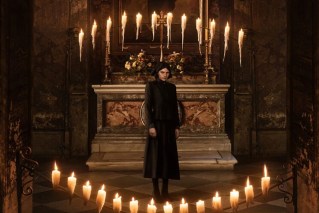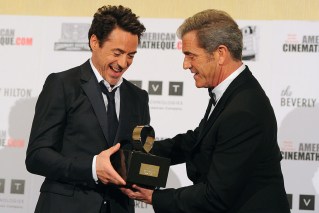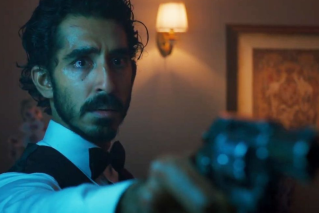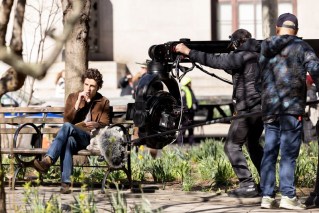New Neil Armstrong movie at the centre of ‘ridiculous’ controversy
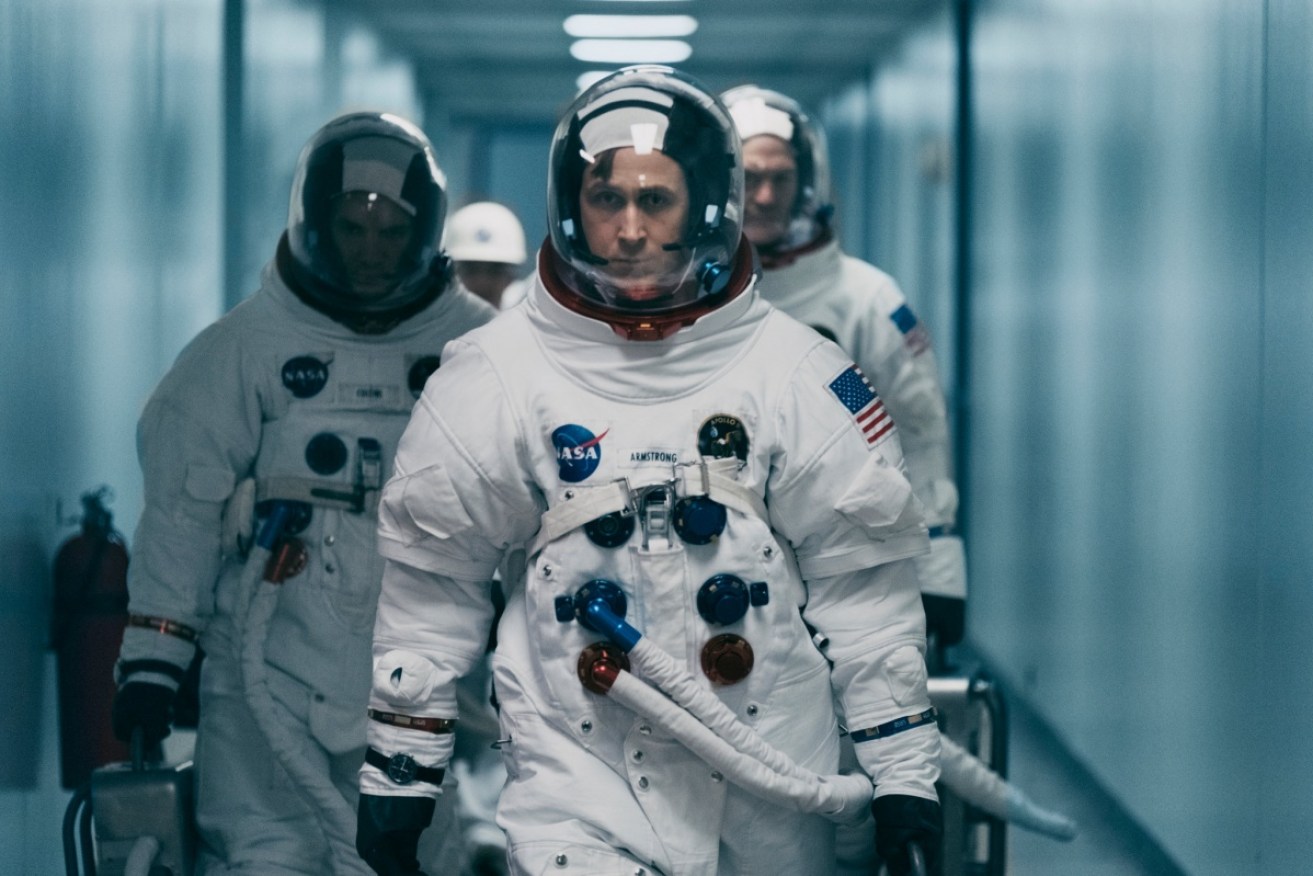
Ryan Gosling as Neil Armstrong in First Man. Photo: NYT
Before anyone in North America had a chance to see First Man — which is to say before it had its premiere on Friday at the 45th Telluride Film Festival — it was already the subject of a ridiculous ideological controversy.
The film, directed by Damien Chazelle (La La Land), tells the story of the Apollo 11 moon landing, focusing on the career of Neil Armstrong, who is played by Ryan Gosling. Shortly after the movie was shown at the Venice Film Festival, some conservative commentators pounced on the fact that the movie doesn’t depict one of the most familiar images from that lunar voyage, the planting of the American flag on the moon’s surface by Armstrong and his fellow astronaut Buzz Aldrin.
Aldrin publicised his objections to the omission, and complaints spread across social media and conservative outlets like Fox News. Some of the noise floated up into this mountain town, where well-heeled cinephiles and high-altitude movie-world professionals gather each Labor Day weekend to sample selected new films alongside carefully programmed revivals and restorations.
To have seen First Man is to wonder what the fuss was all about, or would be if the fuss did not seem so predictable. Without Chazelle’s movie, the outrage machine would surely have found another equally dubious target.
Never mind that the accusations of anti-Americanism are absurd on their face. It is obvious to anyone paying attention to what’s onscreen that Chazelle wants to encourage his audience to approach a familiar story with fresh eyes.
And so instead of recreating the planting of the flag — which everyone has seen before — he includes a powerful, haunting long-distance shot of the Stars and Stripes flying alongside the landing module, taken from a perspective that would have been impossible in 1969. The point is to suggest how strange, how literally otherworldly, Armstrong’s experience must have been.
Also — and I must say it’s irritating to have to spell this out — there is no shortage of American flag iconography onscreen, and no suggestion in the script that NASA was a Canadian, international or Martian agency. What the critics of First Man miss is the movie’s fundamental conservatism.
That’s not an accusation, but an apt description of a reality-based narrative that grounds its story of American greatness in a pastoral, if sometimes complicated, vision of suburban life and traditional marriage. There are a few scenes of protesters deriding the space program, but First Man hardly takes their side. Its ambitions are aligned with the can-do, odds-defying ethos of the space program. Its hero is both a stubborn individualist and a team player, the quiet central figure in a group portrait of square-jawed, clean-cut guys and their supportive, stoically suffering wives.
OK? It says something about the present moment that a movie so committed to evoking a spirit of national consensus and common purpose should be dragged into the partisan mosh pit. The squall that greeted Chazelle’s movie illustrates some of the risks of historical filmmaking. The past is not a safe place, even if Hollywood often depicts it as a realm of solved problems and settled arguments, to be regarded with nostalgia or relief.

A scene from Mike Leigh’s Peterloo, set in 1819. Photo: Amazon Studios
The backward-looking tendencies of modern cinema were on striking display in Telluride this year. This would usually be the part of the article where I quietly admit that festivals don’t really have themes before blithely yoking together a bunch of movies that suggest otherwise. But it does seem to me that the “based on a true story” approach has become one of the defining traits of the kind of prestige filmmaking that Telluride increasingly exists to promote. Biopics, costume dramas, dramatisations of significant (or obscure) events — these are among the dominant non-superhero, “serious” movies of our time, and this festival’s recent history is full of them.
This year, visitors to Telluride could travel to Paris in 1961, the scene of Rudolf Nureyev’s defection from the Soviet Union, in Ralph Fiennes’ The White Crow; to Mexico City in the 1970s in Roma, Alfonso Cuarón’s wondrous re-creation of the world of his childhood; to Poland in the ‘50s in Pawel Pawlikowski’s Cold War; to the mills of northern England in 1819 in Mike Leigh’s Peterloo; and to the court of Queen Anne more than a century before, in Yorgos Lanthimos’ The Favourite.
In The Old Man and the Gun, Robert Redford plays a gentlemanly bank robber plying his trade (and courting Sissy Spacek) in the 1980s. In Can You Ever Forgive Me? Melissa McCarthy is a literary forger doing her thing (and bantering with Richard E. Grant) in early-’90s Manhattan.
Even the most overtly present-tense movie I saw — Olivier Assayas’ Non Fiction, which doesn’t claim to be based on a true story — had a subtly retrospective ambience. The characters, Parisians who work in publishing, media and politics, are preoccupied with the effect of digital technology on their lives and livelihoods. Like most discussions of the digital future, their arguments sound instantly obsolete. Hearing them talk about blogging and e-books I wondered for a moment if the movie was supposed to be set in 2010, or even earlier. Their conversations about sex seem to be taking place about 15 minutes before the arrival of the #MeToo movement.
The present slides rapidly into the past, and the past offers clues and analogies to the present. How was then like now? How did we get from there to here? A movie can seem relevant to current circumstances without being too specific. Thus The Front Runner, Jason Reitman’s film about the tabloid sex scandal that torpedoed Gary Hart’s presidential candidacy in 1988, can suggest all kinds of parallels that don’t need spelling out. And Charles Ferguson’s Watergate, a four-hour documentary about that scandal, invites the viewer to muse on analogies and discrepancies and to ponder the possible lessons of its subtitle: “How We Learned to Stop an Out-of-Control President.”

Alfonso Cuarón looks back to 1970s Mexico City in Roma. Photo: Netflix
Peterloo, meanwhile, insists, with an urgency more Marxist than Faulknerian, that the past is not past at all. Unabashedly talky and unapologetically angry, Leigh’s film chronicles the debates and machinations leading up to a massacre of demonstrators marching for electoral reform and workers’ rights. Its intention is less to commemorate a bygone tragedy than to illuminate the unfinished business of justice and the endlessness of the struggle for democracy.
While Peterloo is an indictment of the abuse of power, The Favourite is a celebration of the power to abuse. A kinky variation on All About Eve, the film, like Lanthimos’ previous work (Dogtooth and The Lobster in particular) unfolds in a highly structured society where tenderness can be a form of cruelty and vice versa. Emma Stone and Rachel Weisz are rivals for the favour of the queen, who is played with almost indescribable magnificence — she’s pitiful, imperious, grotesque and commanding, sometimes all at the same time — by Olivia Colman. This is a political movie not because of the argument it makes, but because of the sharp delineations of its characters’ motives, which are cynical, selfish and also sometimes disarmingly sincere.
I’ve saved my own favourite for last. Roma, named for the upper-middle-class Mexico City neighbourhood where Cuarón grew up, has a lot to say — or rather, to show — about class, ethnicity and political conflict. There are riots in the street and tensions in the household where the story unfolds. The main character is Cleo (Yalitza Aparicio), who works as a maid in the home of a wealthy doctor, caring for his four children and cleaning up after the family dog. Her life, and the lives of her employers, are realised in lovely widescreen black-and-white images, brought to life by Cuarón’s graceful, kinetic, often thrilling camera movements. From the raw material of memory he’s made something that nearly erases the difference between artifice and life, as well as the distance between past and present. It’s pure now, and it will never get old.
–The New York Times

